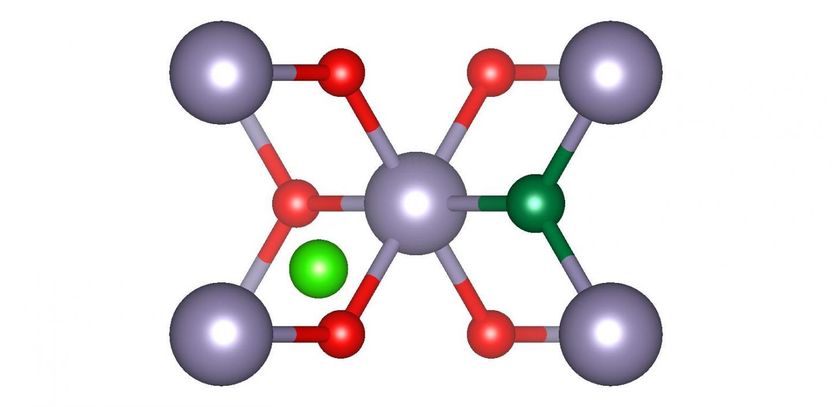The way to better and cheaper transparent conductors
Researchers at the University of Liverpool have made a discovery that could improve the conductivity of a type of glass coating which is used on items such as touch screens, solar cells and energy efficient windows.

Compensating acceptor fluorine interstitials (light green) dramatically reduce electronic performance of tin dioxide transparent conducting glass coatings doped with fluorine atoms (dark green).
University of Liverpool
Coatings are applied to the glass of these items to make them electrically conductive whilst also allowing light through. Fluorine doped tin dioxide is one of the materials used in commercial low cost glass coatings as it is able to simultaneously allow light through and conduct electrical charge but it turns out that tin dioxide has as yet untapped potential for improved performance.
Physicists identify the factor that has been limiting the conductivity of fluorine doped tin dioxide, which should be highly conductive because fluorine atoms substituted on oxygen lattice sites are each expected to give an additional free electron for conduction.
The scientists report, using a combination of experimental and theoretical data, that for every two fluorine atoms that give an additional free electron, another one occupies a normally unoccupied lattice position in the tin dioxide crystal structure.
Each so-called "interstitial" fluorine atom captures one of the free electrons and thereby becomes negatively charged. This reduces the electron density by half and also results in increased scattering of the remaining free electrons. These combine to limit the conductivity of fluorine doped tin dioxide compared with what would otherwise be possible.
PhD student Jack Swallow, from the University's Department of Physics and the Stephenson Institute for Renewable Energy, said: "Identifying the factor that has been limiting the conductivity of fluorine doped tin dioxide is an important discovery and could lead to coatings with improved transparency and up to five times higher conductivity, reducing cost and enhancing performance in a myriad of applications from touch screens, LEDs, photovoltaic cells and energy efficient windows."
The researchers now intend to address the challenge of finding alternative novel dopants that avoid these inherent drawbacks.
Original publication
Jack E. N. Swallow, Benjamin A. D. Williamson, Thomas J. Whittles, Max Birkett, Thomas J. Featherstone, Nianhua Peng, Alex Abbott, Mark Farnworth, Kieran J. Cheetham, Paul Warren, David O. Scanlon, Vin R. Dhanak, Tim D. Veal; "Self‐Compensation in Transparent Conducting F‐Doped SnO2"; Adv. Funct. Mater.; 2017
Most read news
Original publication
Jack E. N. Swallow, Benjamin A. D. Williamson, Thomas J. Whittles, Max Birkett, Thomas J. Featherstone, Nianhua Peng, Alex Abbott, Mark Farnworth, Kieran J. Cheetham, Paul Warren, David O. Scanlon, Vin R. Dhanak, Tim D. Veal; "Self‐Compensation in Transparent Conducting F‐Doped SnO2"; Adv. Funct. Mater.; 2017
Topics
Organizations
Other news from the department science
These products might interest you

OCA 200 by DataPhysics
Using contact angle meter to comprehensively characterise wetting behaviour, solids, and liquids
With its intuitive software and as a modular system, the OCA 200 answers to all customers’ needs

Tailor-made products for specific applications by IPC Process Center
Granulates and pellets - we develop and manufacture the perfect solution for you
Agglomeration of powders, pelletising of powders and fluids, coating with melts and polymers

Dursan by SilcoTek
Innovative coating revolutionizes LC analysis
Stainless steel components with the performance of PEEK - inert, robust and cost-effective

Get the chemical industry in your inbox
By submitting this form you agree that LUMITOS AG will send you the newsletter(s) selected above by email. Your data will not be passed on to third parties. Your data will be stored and processed in accordance with our data protection regulations. LUMITOS may contact you by email for the purpose of advertising or market and opinion surveys. You can revoke your consent at any time without giving reasons to LUMITOS AG, Ernst-Augustin-Str. 2, 12489 Berlin, Germany or by e-mail at revoke@lumitos.com with effect for the future. In addition, each email contains a link to unsubscribe from the corresponding newsletter.




























































